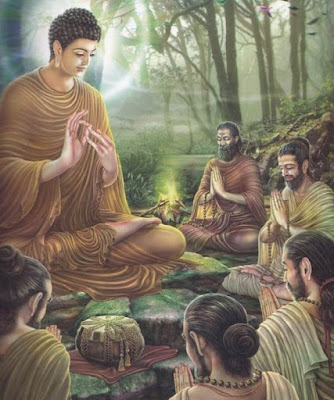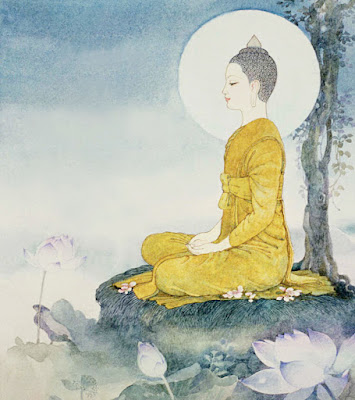The Buddha
The man who was to become the Buddha was born Siddhattha Gotama around 2,600 years ago as a Prince of a small territory near what is now the Indian-Nepalese border. Though he was raised in splendid comfort, enjoying aristocratic status, no amount of material pleasure could satisify the enquiring and philosophic nature of the young man. At the age of 29 he left palace and family to search for a deeper meaning in the secluded forests and remote mountains of North-East India. He studied under the wisest religious teachers and philosophers of his time, learning all they had to offer, but he found it was not enough. He then struggled alone with the path of self- mortification, taking that practice to the extremes of asceticism, but still to no avail.
Then, at the age of 35, on the full moon night of May, he sat beneath the branches of what is now known as the Bodhi Tree, in a secluded grove by the banks of the river Neranjara, and developed his mind in deep but luminous, tranquil meditation. Using the extraordinary clarity of such a mind with its sharp penetrative power generated by states of deep inner stillness, he turned his attention to investigate upon the hidden meanings of mind, universe and life. Thus he gained the supreme Enlightenment experience and from that time on he was known as the Buddha. His Enlightenment consisted of the most profound and all-embracing insight into the nature of mind and all phenomena. This Enlightenment was not a revelation from some divine being, but a discovery made by Himself and based on the deepest level of meditation and the clearest experience of the mind. It meant that He was no longer subject to craving, ill-will and delusion but was free from their shackles, having attained the complete ending of all forms of inner suffering and acquired unshakeable peace.
The Teachings of the Buddha
Having realized the goal of Perfect Enlightenment, the Buddha spent the next 45 years teaching a Path which, when diligently followed, will take anyone regardless of race, class or gender to that same Perfect Enlightenment. The Teachings about this Path are called the Dhamma, literally meaning "the nature of all things" or "the truth underlying existence". It is beyond the scope of this pamphlet to present a thorough description of all of these Teachings but the following 7 topics will give you an overview of what the Buddha taught:
1. The way of Inquiry
The Buddha warned strongly against blind faith and encouraged the way of truthful inquiry. In one of His best known sermons, the Kalama Sutta, the Buddha pointed out the danger in fashioning one's beliefs merely on the following grounds: on hearsay, on tradition, because many others say it is so, on the authority of ancient scriptures, on the word of a supernatural being, or out of trust in one's teachers, elders, or priests. Instead one maintains an open mind and thoroughly investigates one's own experience of life. When one sees for oneself that a particular view agrees with both experience and reason, and leads to the happiness of one and all, then one should accept that view and live up to it!
This principle, of course, applies to the Buddha's own Teachings. They should be considered and inquired into using the clarity of mind born of meditation. Only when one sees these Teachings for oneself in the experience of insight, do these Teachings become one's Truth and give blissful liberation.
The traveller on the way of inquiry needs the practice of tolerance. Tolerance does not mean that one embraces every idea or view but means one doesn't get angry at what one can't accept.
Further along the journey, what one once disagreed with might later be seen to be true. So in the spirit of tolerant inquiry, here are some more of the basic Teachings as the Buddha gave them.
2. The Four Noble Truths
The main Teaching of the Buddha focuses not on philosophical speculations about a Creator God or the origin of the universe, nor on a heaven world ever after. The Teaching, instead, is centred on the down-to- earth reality of human suffering and the urgent need to find lasting relief from all forms of discontent. The Buddha gave the simile of a man shot by a poison-tipped arrow who, before he would call a doctor to treat him, demanded to know first who shot the arrow and where the arrow was made and of what and by whom and when and where ... this foolish man would surely die before his questions could be well answered. In the same way, the Buddha said, the urgent need of our existence is to find lasting relief from recurrent suffering which robs us of happiness and leaves us in strife.
Philosophical speculations are of secondary importance and, anyway, they are best left until after one has well trained the mind in meditation to the stage where one has the ability to examine the matter clearly and find the Truth for oneself.
Thus, the central Teaching of the Buddha, around which all other teachings revolve is the Four Noble Truth
1. That all forms of being, human and otherwise, are afflicted with suffering.
2. That the cause of this suffering is Craving, born of the illusion of a soul (see below, note 7).
3. That this suffering has a lasting end in the Experience of Enlightenment (Nibbana) which is the complete letting go of the illusion of soul and all consequent desire and aversion.
4. That this peaceful and blissful Enlightenment is achieved through a gradual training, a Path which is called the Middle Way or the Eightfold Path.
It would be mistaken to label this Teaching as 'pessimistic' on the grounds that it begins by centring on suffering. Rather, Buddhism is 'realistic' in that it unflinchingly faces up to the truth of life's many sufferings and it is 'optimistic' in that it shows a final end of the problem of suffering - Nibbana, Enlightenment in this very life! Those who have achieved this ultimate peace are the inspiring examples who demonstrate once and for all that Buddhism is far from pessimistic, but it is a Path to true Happiness.
3. The Middle Way or Eightfold Path
The Way to end all suffering is called the Middle Way because it avoids the two extremes of sensual indulgence and self-mortification. Only when the body is in reasonable comfort but not over-indulged has the mind the clarity and strength to meditate deeply and discover the Truth. This Middle Way consists of the diligent cultivation of Virtue, Meditation and Wisdom, which is explained in more detail as the Noble Eightfold Path.
1. Right Understanding
2. Right Thought
3. Right Speech
4. Right Action
5. Right Livelihood
6. Right Effort
7. Right Mindfulness
8. Right Concentration
Right Speech, Action and Livelihood constitute the training in Virtue or Morality. For a practicing Buddhist it consists of maintaining the five Buddhist Precepts, which are to refrain from:
1. Deliberately causing the death of any living being;
2. Intentionally taking for one's own the property of another;
3. Sexual misconduct, in particular adultery;
4. Lying and breaking promises;
5. Drinking alcohol or taking stupefying drugs which lead to lack of mindfulness.
Right Effort, Mindfulness and Concentration refer to the practice of Meditation, which purifies the mind through the experience of blissful states of inner stillness and empowers the mind to penetrate the meaning of life through profound moments of insight.
Right Understanding and Thought are the manifestation of Buddha-Wisdom which ends all suffering, transforms the personality and produces unshakable serenity and tireless compassion.
According to the Buddha, without perfecting the practice of Virtue it is impossible to perfect Meditation, and without perfecting Meditation it is impossible to arrive at Enlightenment Wisdom. Thus the Buddhist Path is a Gradual Path, a Middle Way consisting of Virtue, Meditation and Wisdom as explained in the Noble Eight fold Path leading to happiness and liberation.
share with your friends
Don't forget to follow our page










Comments
Post a Comment